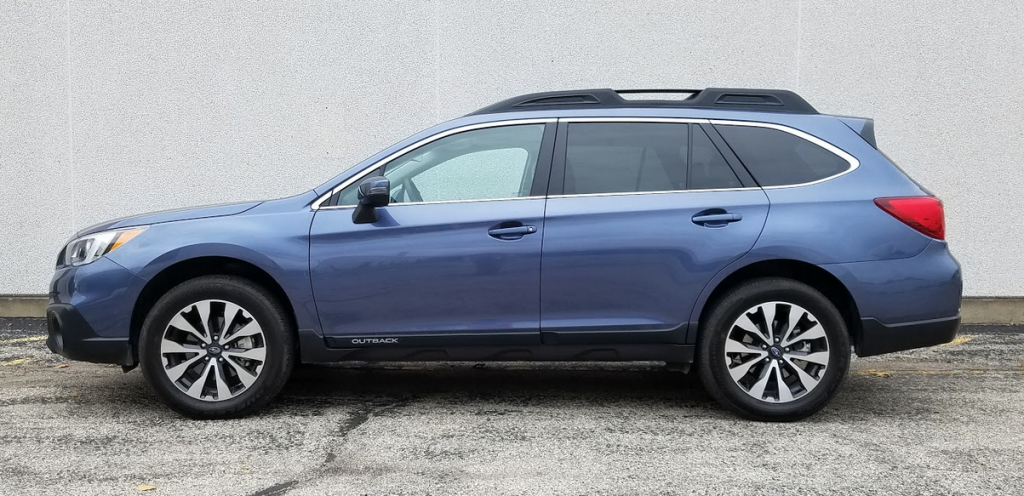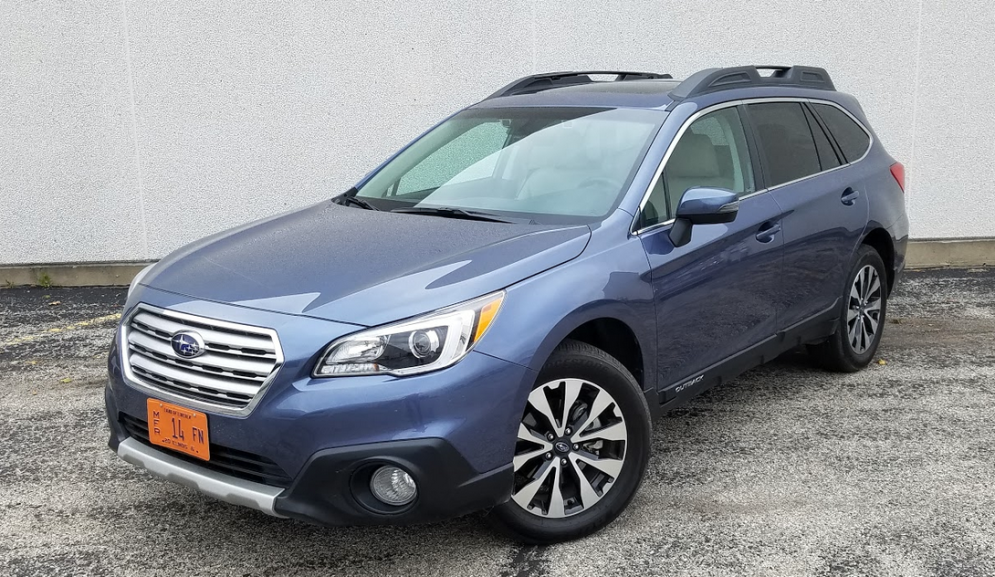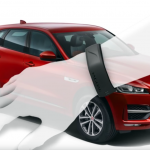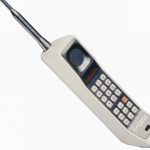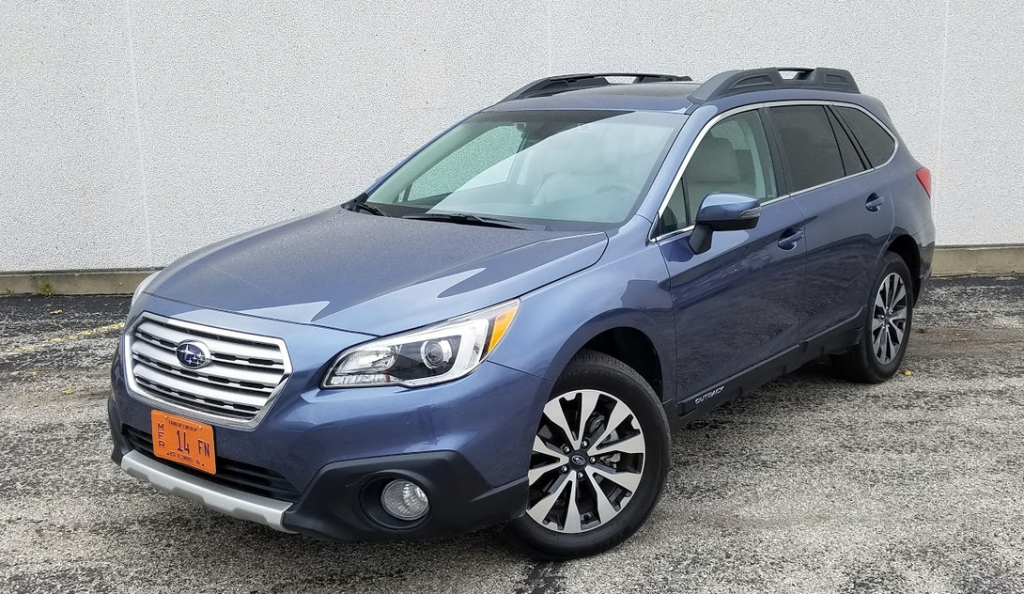
2017 Subaru Outback 3.6R Limited 
Class: Midsize Car
Miles Driven: 248
Fuel Used: 12.4 gallons
Real-world fuel economy: 20.0 mpg
Driving mix: 70% city, 30% highway
EPA-estimated fuel economy: 20/27/22 (city/highway/combined)
| CG Report Card | |
|---|---|
| Room and Comfort | B+ |
| Power and Performance | B- |
| Fit and Finish | B |
| Fuel Economy | C+ |
| Value | B |
| Report-card grades are derived from a consensus of test-driver evaluations. All grades are versus other vehicles in the same class. Value grade is for specific trim level evaluated, and may not reflect Consumer Guide's impressions of the entire model lineup. | |
| Big & Tall Comfort | |
| Big Guy | B |
| Tall Guy | A- |
| Big & Tall comfort ratings are for front seats only. "Big" rating based on male tester weighing approximately 350 pounds, "Tall" rating based on 6'6"-tall male tester. | |
Base price: $34,995 (not including $875 destination charge)
Options on test car: Option Package 23: includes STARLINK Multimedia Navigation System, EyeSight Driver-Assist System, Steering Responsive Fog Lights, High Beam Assist, and Reverse Automatic Braking System ($1595)
Price as tested: $37,465
Quick Hits
The great: Roomy, comfortable cabin
The good: Proven foul-weather/off-road capability
The not so good: Mediocre fuel economy with 6-cylinder engine
Check out Consumer Guide’s Midsize Car Best Buys
John Biel
Since Consumer Guide® last tested a Subaru Outback, a redesigned 2015 model, the manufacturer has seen fit to move slowly. Having added the availability of more tech features and tinkered with the steering and suspension in 2016, Subaru gives the ’17 Outback a new top-end Touring model, and puts a couple more safety items on the options list. As such, the SUV-tinged station wagon remains a useful and versatile alternative to the sedans in the midsize segment.

The most obvious difference between CG’s most recent Outback test car and its previous one had nothing to do with the passage of time but everything to do with what was under the hood. Where the ’15 was powered by a 2.5-liter 175-horsepower 4-cylinder engine, the ’17 was motivated by a 3.6-liter 256-horse 6-cylinder powerplant.
Both Outback engines are of Subaru’s preferred horizontally opposed “boxer” type, and both are joined to an automatic-like continuously variable transmission (CVT). As expected, the 3.6 comes with considerably more torque (73 additional lb-ft) that hits its peak at just 400 more rpm than it takes the 2.5 to muster all of its strength, so the six is quite a bit livelier, and it cruises calmly and fairly quietly. However, if you tromp on the gas to make a pass, some noise will come up as the engine races while the CVT whirrs along without the prompt kickdown of a good stepped-gear automatic. Oddly, this driver actually saw better fuel mileage with the six—21.60 mpg after a 176-mile stint with 70 percent city driving—than he did with the 2015 test car. EPA estimates for the 3.6 are 20 mpg in city driving, 27 mpg on the highway, and 22 combined.
Test Drive: 2016 Toyota RAV4 Hybrid XLE

As in 2015, CG’s latest Outback test car came as a Limited model. Like each and every Outback it was equipped with all-wheel drive, selectable “X-Mode” traction-assist, and hill-descent control. Other standards, some of which kick in at the Limited level, included soft-touch surfaces on much of the door panels and dashboard; satin-finish woodgrain accents on the dash and doors; supportive and comfortable perforated-leather seats; reclining rear seat backs; 7-inch central touchscreen; dual-zone climate system; heated front and rear seats; rearview camera; blind-spot detection; rear cross-traffic alert; roof rails with cross bars; power liftgate with memory function; STARLINK infotainment with smartphone app integration, Bluetooth connectivity, and Internet and satellite radio; remote keyless entry; push-button starting; 18-inch alloy wheels; and moonroof.

Base price comes to $34,995—though that includes a $2605 premium for the 6-cylinder engine (and standard high-intensity-discharge headlights not found on the 2.5-liter Limited). CG’s test car topped out at a considerable $37,465 with delivery and a substantial option package composed of navigation, an “EyeSight” suite of electronic lane-management and collision-mitigation systems, steering-responsive fog lights, automatic headlight high-beam control, and reverse automatic braking. The last two items listed are new additions to the Outback’s bag of safety tricks.
First Spin: 2017 Volkswagen Golf Alltrack
The Outback handles easily with light but not flabby steering. For a vehicle with a whiff of SUV about it, the ride is surprisingly compliant.
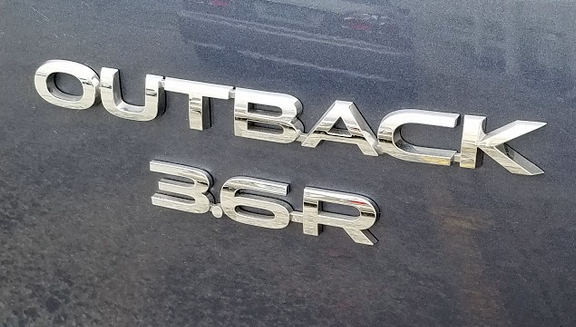
Headroom is good above all passenger positions. Drivers and front passengers can find plentiful stretch-out space. Adults riding in back have fine legroom, especially with front seat backs that are deeply sculpted to add space. The driveline hump is prominent enough to limit comfortable seating to two grown-ups, though a third might fit in a pinch. Big windows and slender roof pillars provide an airy feel to the cabin, and excellent all-around driver vision.
As for controls, an external tuning knob (on the far side of the touchscreen from the driver’s seat) simplifies selection of radio stations, with only a press on the screen necessary to save them as presets. Buttons on either side of the screen summon other systems like navigation or apps. Climate controls rely on buttons and a pair of rotary dials to make temperature settings. Digital time and temperature readings register on a small strip screen that fades when viewed through polarized sunglasses. There’s a clearly marked trip-odometer-reset button on the dash; the back of the center console holds buttons for the rear seat heaters.
Interior storage starts with a glove box big enough to hold the owner’s manual but little else. Pockets in all four doors incorporate bottle holders but the rear pockets have very little room for much more. The deep padded-top console box includes a shallow tray with a coin organizer. The console also holds twin open cup holders and a bin under a pop-up door that contains auxiliary and USB inputs. Rear passengers get a pouch on the back of each front seat and a pull-down center armrest with two cup holders.
Living up to its station-wagon promise, the Outback’s ample cargo area loads at bumper height onto a molded mat designed to trap dirt and water. A hatch in the cargo floor lends access to the spare tire and tools, as well as some hidden flat-item storage. Tie-downs and a power point are provided in the cargo area. The rear 60/40-split seat backs can be dropped remotely via levers in the cargo area or more directly through flippers built into the seats. When the seats are folded, they rest very nearly flat and with no interruption from the cargo floor.
Subaru has kept a good thing going in the Outback. Though top-end prices can get somewhat high (the Limited is the cheapest 6-cylinder model), the parts that make it distinctive and useful are available throughout the line.
